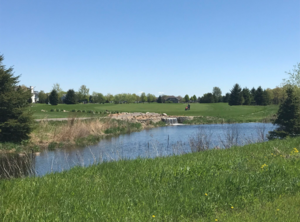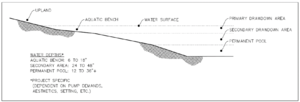
Design considerations for constructed stormwater ponds used for harvest and irrigation use/reuse
Stormwater ponds can be used as the storage component of a stormwater harvest and use system. These ponds are multi-purpose, providing stormwater retention, sedimentation, and storage for later use. In this way, stormwater harvest and use systems can be part of a treatment train approach for stormwater management. Existing ponds can be retrofitted to serve as a water source for a harvest and use system.
Contents
Permit requirements
If the pond is designed to meet the Construction Stormwater General Permit, several requirements must be met. Those are summarized here.
Design considerations for ponds used for harvest and use
The first question to ask before selecting a constructed stormwater pond as the BMP is whether a pond is the most appropriate BMP. If the goal is to meet a volume retention requirement and the retention requirement can be met through infiltration of stormwater, then stormwater infiltration practices should be considered. On soils conducive to infiltration and where site constraints do not exist, infiltration will typically be the most appropriate BMP. However, if site goals include other factors, such as replacing a water supply or irrigation of vegetation, harvest and use is an appropriate BMP.
Ponds should be designed following guidance in pond design guidance section of this manual. However, there are or may be specific design considerations for stormwater ponds used in harvest and use/reuse systems. These design considerations are summarized below.
- Reuse of stormwater from a pond treating runoff from potential stormwater hotspots may pose a public safety & welfare concern, as well as may be cost prohibitive to pre-treat if special filter devices are required.
- Stormwater and rainwater harvest and use/reuse systems may require a water-supply well to supplement irrigation needs when runoff is not available. A minimum horizontal distance of 35 feet may apply.
- Important to maintain a permanent pool depth below which no pumping occurs to prevent resuspension of sediment.
- Multiple aquatic benches may be necessary for ponds that experience repeated bounce or drawdown due to irrigation reuse. An alternative to multiple aquatic benches would be mild side slopes of 5:1 from the bench downward to the permanent pool elevation, then grade downward as necessary. These considerations are dependent on aesthetics, adjacent land use (residential vs. commercial, etc.), and objectives for operations and maintenance.
- Ponds that experience repeated bounce or drawdown due to irrigation reuse may create an environment for invasive vegetation species. Some of these species may include an abundance of volunteer sandbar willow and cottonwood, which may need to be removed.
- Pump house, control panels, intake and discharge pumps, electrical controls, etc. need to be secure to prevent public access.
- The operator will need to access the reuse system for operations & maintenance, therefore a well thought out landscape plan needs to be prepared.
Additional considerations
Below is a list of additional considerations that are not specifically addressed above.
- Some stormwater pond owners prefer inlet pipe inverts be submerged to reduce erosion. Consideration should be given to pipe material and diameter. Reinforced concrete pipe (RCP), with tied joints may last longer than high density polyethylene pipe (HDPE) or corrugated metal pipe (CMP), which both can become buoyant when submerged, and even damaged from repetitive ice heave. In addition, the diameter of the pipe entering the pond may be oversized to account for submerged inverts, and reduced capacity. This is applicable to all constructed ponds.
- Adequate sediment storage must be provided to preserve reservoir capacity for intended use(s)
- Pond must be properly designed. This includes consideration of local codes and watershed district rules, water quality targets for both the intended use, and water quality goals for water captured by the pond but not used for the intended use (e.g. water discharged to a surface water body via the storm sewer system).
- Is lining the pond with topsoil or clay necessary to hold water for use or prevent infiltration in Groundwater Protection Areas? If soil infiltration rates are high in the underlying soils, have infiltration BMPs been considered for stormwater management?
- What is the depth of the pond at normal water level (NWL) and after drawdown for irrigation?
- Does a drawdown limit need to be set with a flow to maintain sufficient water levels for pond aesthetics? Can a buffer of tall, native vegetation be used to improve aesthetics during drawdown?
- Will there be limitations to vegetation established due to water level bounce and drawdown?
- Consider the potential for erosion from inlets and sideslopes under low pond water levels.
- To discourage the growth of algae and other microorganisms, ponds should be sized such that detention times are not excessive during warm weather. As temperatures increase, the recommended maximum detention time decreases (Met Council, 2011). This is not likely to be a concern for reuse ponds since detention times are typically short. The following table is from the Met Council Reuse Guide Storage Systems Toolbox I.2, originally adapted from New South Wales Department of Environment and Conservation, Managing Urban Stormwater, Harvesting and Reuse, April 2006:
Maximum Detention Time - Average Daily Temperature
Link to this table
| Maximum Detention Time (days) to limit algae blooms: | Average Daily Temperature (F) |
|---|---|
| 50 | 59 |
| 30 | 68 |
| 20 | 77 |
Related pages
- Overview for stormwater ponds
- Types of stormwater ponds
- Design criteria for stormwater ponds
- Design considerations for constructed stormwater ponds used for harvest and irrigation use/reuse
- Construction specifications for stormwater ponds
- Assessing the performance of stormwater ponds
- Operation and maintenance of stormwater ponds
- Cost-benefit considerations for stormwater ponds
- Calculating credits for stormwater ponds
- Stormwater wet pond fact sheet
- References for stormwater ponds
- Requirements, recommendations and information for using stormwater pond as a BMP in the MIDS calculator
This page was last edited on 29 December 2022, at 17:04.


